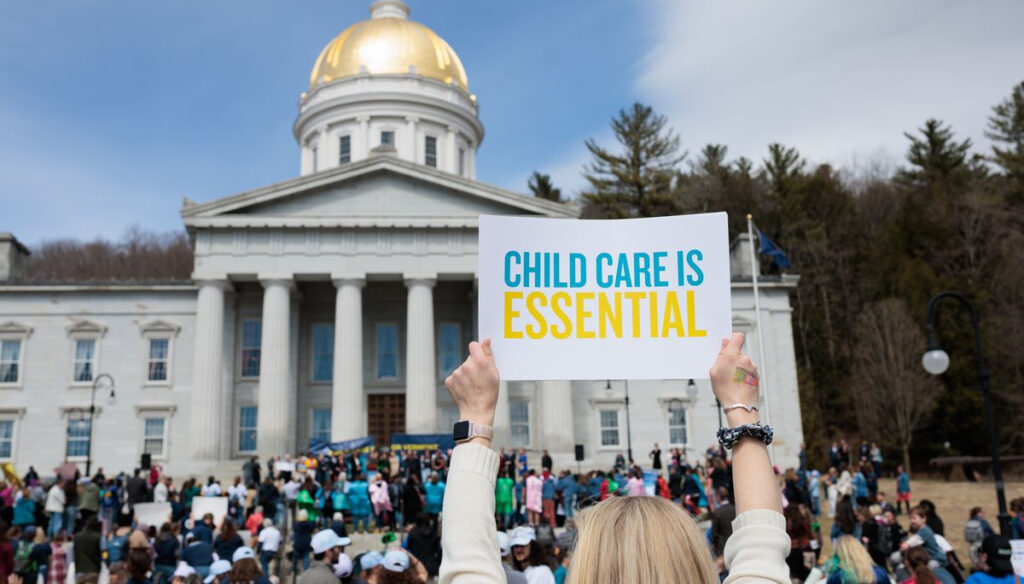Inside the winning fight in Vermont.
By Rachel M. Cohen@rmc031rachel.cohen@voxmedia.com May 22, 2023, 7:00am EDT
Share this story
/cdn.vox-cdn.com/uploads/chorus_image/image/72301688/LGK___Courage_To_Care_Rally__BDP_0271.0.jpg)
Rachel M. Cohen is a senior reporter for Vox covering social policy. She focuses on housing, schools, labor, criminal justice, and abortion rights, and has been reporting on these issues for more than a decade.
Action in Congress to support child care has been stalled for years. But in Vermont, lawmakers have just approved an ambitious plan that would pour tens of millions of new dollars into the state’s starved child care system.
The bill authorizing $125 million in annual investment comes after nearly a decade of organizing. As in many states, thousands of Vermont kids lack access to any child care program, and among families that have been able to land competitive slots, average costs exceed $26,000 a year, more than 30 percent of many families’ household income.
Meanwhile, child care workers are some of the lowest paid employees in the state, earning about $15 per hour, and typically with no benefits. Given that their workers could make more money doing just about anything else, programs struggle to hire and retain staff — adding additional stress to parents who can’t rely on their child care programs to stay open.
The newly approved child care bill would expand state subsidies for families earning up to 575 percent of the federal poverty level (or $172,000 for a family of four) and families earning up to 175 percent of the poverty line (or $52,000 for a family of four) would now pay nothing out of pocket.
The new payments will mean an infusion of funds for child care, allowing providers to be reimbursed at a 35 percent higher rate than they currently are. The legislation also tasks lawmakers with studying how to create an affordable full-day pre-K system.
The investments would be paid for in part by a new payroll tax, of which employers would cover at least 75 percent. It’s not law yet — it’s headed to Republican Gov. Phil Scott’s desk, who has previously said he would reject any new taxes. His office did not return request for comment, but Democrats have a supermajority in the Vermont legislature and have made clear they would override any veto in June.
Vermont’s legislative victory comes nearly a year after the Inflation Reduction Act passed the US Senate without any child care provisions, a gutting blow after the House had approved a $390 billion investment in November 2021. The Vermont victory also comes as federal pandemic child care subsidies are expiring, and President Joe Biden looks to make child care a top priority heading into his reelection campaign. Last month, Biden signed new executive orders to boost child care programs and their workers.
The path to victory in Vermont offers a roadmap for activists in other states who want to see increased public investment into their child care systems, and insight into the policy trade-offs leaders had to make for their measure to get through the legislative process.
“Vermont showed that you can have a bold vision, cultivate a broad base of support, persevere though budget battles and pandemics, and make the state a better place for those who don’t have a voice in politics,” said Helene Stebbins, the executive director of the Alliance for Early Success, a national nonprofit that supports early childhood advocacy. “The hard part is not the policy — it’s the strategy, and the patience.”
How Vermont built its winning coalition
The origins of Vermont’s child care campaign trace back to 2000, when a Burlington real estate developer named Rick Davis and his friend in private equity, Carl Ferenbach, launched a foundation dedicated to supporting Vermont children.
For its first decade, the foundation focused on a range of initiatives, including youth centers, programs for kids with incarcerated parents, and supporting new community pre-K programs. This work helped prompt Vermont legislators to pass a bill in 2014 requiring all school districts to offer at least 10 hours per week of publicly funded pre-K.
Yet huge gaps remained, and the philanthropists grew more interested in the emerging research demonstrating the cognitive importance of a child’s earliest years. Teaming up and pooling money with other foundations interested in children’s issues, the two men launched Let’s Grow Kids in 2014 to boost child care access, an area they thought would carry the most bang for their charitable buck. They pointed to economic studies that found every dollar spent on high-quality early childhood programs yielded a return of $4-$9.
“Everybody knows we should invest early to save money down the road,” explained Davis, who often framed his work in terms of economic development. “We’ve got to find ways to get young families to come to Vermont and stay.”
In 2015, Bob and Christine Stiller, the founders of Vermont-based Green Mountain Coffee Roasters, gave Let’s Grow Kids a massive $20 million gift, and the group pledged to achieve their mission by 2025. This so-called venture philanthropy idea was to essentially use foundations as a catalyst for legislative change.
Let’s Grow Kids assembled a powerful team of lobbyists and organizers to lead the campaign. In 2015, Davis recruited Aly Richards, a top aide to Vermont Gov. Peter Shumlin, to serve as CEO. While working for Shumlin, Richards led the push to establish Vermont’s universal pre-K program. Other Let’s Grow Kids leaders included a former lobbyist for victims’ rights and a campaigner for legalizing same-sex marriage.
The philanthropic investments helped support statewide organizing, ultimately bringing more than 35,000 Vermonters into the campaign. Volunteers wrote op-eds, signed petitions and pledges, turned out for rallies, and testified before state lawmakers. Let’s Grow Kids also funded television ads and digital marketing, and organized 1:1 meetings with politicians. They helped mobilize child care workers to share their stories, and during the 2016 election, they asked all state candidates how they would address Vermont’s child care problem, and posted their responses online.
Let’s Grow Kids conceived of their strategy from scratch but studied lessons from other winning campaigns like Freedom to Marry. “We’re very small, very nimble, and we had an opportunity and responsibility to be a pioneer,” Richards said.
In 2021, with just four years left until their organization planned to shut down, Let’s Grow Kids established a sister 501(c)4 organization to exert more power in the 2022 midterms. Their goal was to support candidates who not only committed to prioritizing child care, but who also would commit to increasing public investment. Let’s Grow Kids ultimately endorsed 130 candidates last cycle, of which 117 won in November. This led to the first-ever coalition of self-described child care champions headed to Montpelier.
The political compromises lawmakers had to make
Partly spurred by the Let’s Grow Kids campaign, Vermont lawmakers passed a law in 2021 setting goals to expand child care slots, to limit family child care spending to no more than 10 percent of their annual income, and to pay early childhood educators comparable wages as kindergarten teachers in public schools.
Policymakers then commissioned a study to figure out how much that would all cost. To meet all those objectives, state officials would need to raise between $179 million and $279 million in new public funding, according to a report led by the Rand Corporation published this past January. The consultants suggested instituting a new payroll tax, a new sales tax, or a new services tax to get it done.
Even coming in this year with a Democratic supermajority, new committed legislative champions, and a well-funded lobbying effort, the last few months in Montpelier demonstrated the tough political compromises inherent to passing any new program.
Lawmakers said they weren’t ready to commit to spending as much as the Rand report recommended. When the legislative session began, Vermont Senate lawmakers proposed instead expanding child care subsidies for families earning up to 600 percent of the federal poverty level, (or $180,000 for a family of four), paid for by a new payroll tax funded primarily by employers. They thought this was fair, as child care largely provides a benefit to employers. To help fund those new subsidies, Senate lawmakers also proposed repealing a $1,000-per-child tax credit Vermont authorized last year.
In the House, lawmakers favored keeping the child tax credit in place and instead wanted to fund child care investments via a new progressive corporate and personal income tax. In this scenario, wealthier individuals and businesses would finance the bulk of the new revenue, but all taxpayers would still help contribute to a social program that benefits the greater good. The chair of the Senate finance committee said she didn’t like taxing people who might not ultimately need child care services.
Lawmakers were gridlocked for weeks, and it was not clear the two chambers would be able to compromise. In the end, House lawmakers agreed to the payroll tax, but funding families only up to 575 percent of the poverty level, not 600 percent, so that the child credit would stay in place.
The final legislation garnered approval from Democrats, progressives, independents, even some Republicans and a Libertarian. “It is not easy to ask Vermonters — any Vermonter — to pay just a little more, which seems to be a theme of this session,” said Republican Rep. Ashley Bartley of Fairfax. “However, the price of inaction is far greater.”
While Let’s Grow Kids didn’t achieve their goal of capping child care costs at 10 percent for all families, advocates have hailed this as a “quantum leap” forward and note they still have two more years left to push for additional investment, as well as to formalize a compensation scale for workers. Higher-income families that won’t receive direct financial assistance will still benefit from new subsidies flowing into the system, which can stabilize the workforce and boost program quality.
Vermont’s child care political blueprint
Not every state has the kind of philanthropic infrastructure Vermont enjoys. Experts say, though, their political roadmap could be replicated elsewhere, including the assemblage of a diverse coalition of parents, grandparents, business leaders, and child care workers.
“I really think that no matter the demographics of a state, no matter the political landscape, there is something that cuts through anything and that’s grassroots mobilization,” Richards told Vox.
:no_upscale()/cdn.vox-cdn.com/uploads/chorus_asset/file/24663652/C2C_1.jpg)
The only other state to take comparable leadership in state child care investments is New Mexico, which successfully organized a ballot measure this past fall that authorizes new money from a state sovereign wealth fund to provide dedicated funding for universal preschool and child care. Like Vermont, the victory came after a decade-long organizing campaign, where early childhood educators helped lead the fight.
While Vermont’s win is yet another example of the child care movement gaining momentum, Jennifer Wells, the director of economic justice at Community Change Action, said the “real lesson” from states like Vermont and New Mexico is that the system is broken, and federal investment is needed to fund the true cost of child care, to pay early educators what they deserve, and to make care affordable for families.
Miriam Calderon, the chief policy officer with Zero To Three, a national advocacy group focused on infants and toddlers, agreed with Wells that states can’t fix this problem alone.
“In the short term this looks like not letting tens of billions of dollars in federal child care funding expire in September and protecting child care funds from deep cuts proposed as part of the default debates,” she said. “Long term, we need to pass the Child Care for Working Families Act, which ensures a strong federal and state partnership in funding the early care and education our babies and toddlers and families deserve.”








